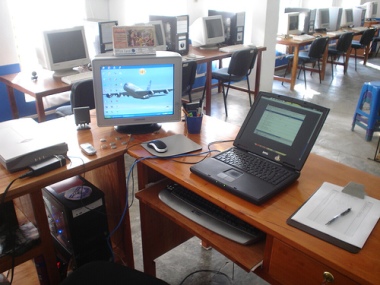 In Part 3 I discussed how the design of URLs can play a big part in forming the initial structure of your new or re-designed intranet. In this post I’ll explain how users and stakeholders can contribute to defining the structure, why iteration is the key to a good intranet structure, why content is important and why thinking of the future is important.
In Part 3 I discussed how the design of URLs can play a big part in forming the initial structure of your new or re-designed intranet. In this post I’ll explain how users and stakeholders can contribute to defining the structure, why iteration is the key to a good intranet structure, why content is important and why thinking of the future is important.
Archive for the 'Knowledge' Category
Designing intranet structures – defining and re-defining your intranet structure (Part 4)
July 31, 2011Planned serendipity for innovation in the workplace
December 3, 2009Knowledge (Part 2) – an enterprise-wide methodology
September 5, 2009 In Part 1 of this post I gave an overview to the process of levering knowledge and creating information (KLIC) in the workplace through carrying out a simple knowledge gap analysis or ‘information audit’. This approach works well when levering knowledge from an individual or small group of people for a particular purpose. But what about an approach that can work across a whole organization as an ongoing knowledge initiative? I was prompted to think about this by a response from someone to the original post who admitted that a lot of this ‘knowledge’ stuff was confusing and was asking for a simple, practical and above all logical methodology or set of tools that could be used by virtually anyone in any organization.
In Part 1 of this post I gave an overview to the process of levering knowledge and creating information (KLIC) in the workplace through carrying out a simple knowledge gap analysis or ‘information audit’. This approach works well when levering knowledge from an individual or small group of people for a particular purpose. But what about an approach that can work across a whole organization as an ongoing knowledge initiative? I was prompted to think about this by a response from someone to the original post who admitted that a lot of this ‘knowledge’ stuff was confusing and was asking for a simple, practical and above all logical methodology or set of tools that could be used by virtually anyone in any organization.
Therefore in this post I will attempt to outline a metholodolgy for carrying out an organization wide knowledge initiative based on an approach that I have found to work very well in the past – the Quality Circle. The approach is fairly non-prescriptive and should be scalable for organizations of different sizes and with varying resources.
Knowledge leverage and information creation in the enterprise
July 24, 2009 In my posts on the Enterprise-wide Information System (EIS) and articles on the Lean Intranet I talk about the role that knowledge should play in the enterprise. Apart from James Robertson you don’t hear many intranet commentators mention ‘knowledge’, yet no organization can function without the knowledge held in staff member’s heads and the shared knowledge that constitute the informal systems that are often at the heart of an organization’s success. If organizations don’t consider knowledge as part of their overall information strategy then they are missing a very big opportunity to improve their processes through the innovative ideas of their staff. They are also in danger of letting important knowledge walk out the door when employees leave.
In my posts on the Enterprise-wide Information System (EIS) and articles on the Lean Intranet I talk about the role that knowledge should play in the enterprise. Apart from James Robertson you don’t hear many intranet commentators mention ‘knowledge’, yet no organization can function without the knowledge held in staff member’s heads and the shared knowledge that constitute the informal systems that are often at the heart of an organization’s success. If organizations don’t consider knowledge as part of their overall information strategy then they are missing a very big opportunity to improve their processes through the innovative ideas of their staff. They are also in danger of letting important knowledge walk out the door when employees leave.
It is my belief that intranet and internal communications workers should be contributing to the knowledge debate, especially when it comes to knowledge in the workplace, if only to ensure that a simple, practical approach is arrived at that can be of value in the enterprise. In this post I will try to outline such an approach in the hope that knowledge issues in the workplace might start to get attention I think they deserve.
The Lean Intranet: Intranet 2.0 and Intranet 3.0
June 28, 2009In the third of three articles on the Lean Intranet, I discuss the implementation of Intranet 2.0 and look beyond to what Intranet 3.0 might look like. You can access the article on the FUMSI website.
If you have any comments I’d be grateful if you could post them here.
Intranets: defining IA and UX in the Enterprise-wide Information System (Part 3)
May 25, 2009 In Part One I discussed the current state of intranets and other information management components that comprise what I call the Enterprise-wide Information System (EIS). I also graphically represented a generic overview of how these components are currently managed. In Part Two I discussed the holistic management of the EIS, how the EIS approach might work in practice and what benefits an organization using the approach might gain.
In Part One I discussed the current state of intranets and other information management components that comprise what I call the Enterprise-wide Information System (EIS). I also graphically represented a generic overview of how these components are currently managed. In Part Two I discussed the holistic management of the EIS, how the EIS approach might work in practice and what benefits an organization using the approach might gain.
In this third and final part I will try to show you what I think a robust EIS might look like and how IA and UX approaches have the potential to improve every component of the system. In this approach the intranet assumes its proper place and becomes the indispensable hub of the Enterprise-wide Information System.
Intranets: defining IA and UX in the Enterprise-wide Information System (Part 2)
May 15, 2009In Part 1 of this post I’ve tried to define a generic Enterprise-wide Information System (EIS) and reflect what is happening currently in many organization’s EIS. I’ve tried to show that the approach to considering information and knowledge transfers is at best fragmented and at worst not done at all. In this second post I’m going to describe the benefits of the EIS approach, how it might relate to IT and knowledge in the enterprise and also to look at the differences in working and managing the EIS as compared to current arrangements.
Intranets: defining IA and UX in the Enterprise-wide Information System (Part 1)
April 21, 2009 In information architecture (IA) and user experience (UX) discussion lists there are bursts of manic activity that periodically break out. Hundreds of posts a day flood the lists; many of them at odds with each other and some quite angrily so. What is it that causes these periodic convulsions? DTDT.
In information architecture (IA) and user experience (UX) discussion lists there are bursts of manic activity that periodically break out. Hundreds of posts a day flood the lists; many of them at odds with each other and some quite angrily so. What is it that causes these periodic convulsions? DTDT.
It stands for ‘defining the damn thing’. Every so often some brave soul sticks his or her head over the parapet and launches a grenade in the form of either an attempted definition of IA/UX or questions a previous definition and a rapid chain reaction then occurs. Personally I think that it is incredibly difficult to define IA and UX as applied to web based activities as the requirements for IAs and UX professionals can vary greatly from case to case. This may in some part be due to –
- Each website design may have some unique features
- Drivers may be different for each site
- Clients expectations for deliverables may vary widely
- Ways of working may differ widely from company to company. What an IA or UX does in one agency may be very different to what’s expected in another
- Influencing factors in the environment may also vary greatly
- As IA and UX design are fairly new disciplines an overall consensus with regard to best practice in many areas has yet to be reached
I think that’s why the favourite answer that many IAs give to general questions is ‘It depends….’
But what about defining what we do with intranets? Could such a definition more easily include information architecture and user experience activities ? I think it’s a possibility. So wish me luck as I’m now going to stick my head over the parapet.
Intranet user research: A methodology for contextual enquiry
March 1, 2009 A good intranet can only be built on the foundation of solid user research. James Robertson talks about this in his excellent article Conducting intranet needs analysis . James discusses several methodologies that can be used but the one I want to focus on is what James calls ‘contextual enquiry’ .
A good intranet can only be built on the foundation of solid user research. James Robertson talks about this in his excellent article Conducting intranet needs analysis . James discusses several methodologies that can be used but the one I want to focus on is what James calls ‘contextual enquiry’ .
To quote James directly –
‘(Contextual enquiry) is a combination of staff interviews and workplace observation that involves exploring issues with a staff member, while situated within their normal working environment. By conducting the interview ‘in context’, it becomes possible to see the resources used by staff when conducting work activities.
The interviewer can also ask the staff member to show them how they complete specific activities, for example, showing how they find a piece of information on the intranet.’
Over the years I’ve found contextual enquiry to be by far the most illuminating, innovative and motivating experience associated with intranet user research.

